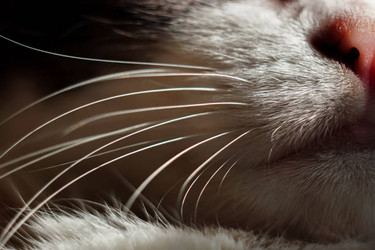Whisker Fatigue - What Is It & What Can You Do About It?
Jun 30th 2025
What Is Whisker Fatigue
To define whisker fatigue, it’s important to first discuss what it is not. It is not a disease and it is not an illness. It is best described as an overload of information from a cat’s very sensitive sensory pathway; the whiskers. When they become overworked, it can become uncomfortable for some cats. But rest assured, there are things you can do as a cat owner to help alleviate this fatigue!
Whiskers Have A Job
If you’ve ever paid close enough attention to cats, you’ve probably noticed that their whiskers are pretty incredible. They are often super long and have a thick base and taper down to a very fine tip at the outward end. Oftentimes the larger the cat, the larger the whiskers. Cat’s whiskers are extraordinarily sensitive and serve mighty functions. They can feel vibrations alerting cats to potential predators and help them keenly navigate in the dark by way of feeling objects at their sides through their whiskers. These whiskers send information to the brain constantly and cats are able to process accordingly. This is a powerful tool and necessary for their survival!
Whiskers & Anatomy
Cats also have relatively flat faces, unlike many dog breeds, which typically have pointier snouts and much shorter whiskers. When cats are eating or drinking, pay attention to their whisker placement. With the anatomy of their faces it makes sense for them to be eating and drinking more on top of their bowl rather than down in. Again, keep in mind their face shape. You’ll notice many bowls on the market for cats are wide and flatter in surface and not deep; this is to accommodate the facial anatomy and not to put stress on a cat’s whiskers while eating or drinking. This is opposite of what you’ll typically see in bowls designed for dogs. Dogs often root around while eating, depending on the type of food, and a deep bowl makes sense. While their feline counterparts grab their food with their tongues in more of a licking fashion.
How To Recognize Whisker Fatigue
If you have a cat that tends to eat or drink trying to get assistance from their paw, flinging food or water from the source and eating from the floor; they might be suffering from whisker fatigue. If you notice your cat pacing or walking up to their food or water bowl, but not wanting to engage with it right away; they might be suffering from whisker fatigue. Or, if your cat is acting hungry or picky, meowing at the bowl and not really desiring to eat; they might have whisker fatigue. These are a few of the most common ways to recognize potential whisker fatigue in your cat. Many times cat owners might have dubbed these behaviors as their cat, being a cat or being naughty when in fact it’s just that their whiskers need a break.
How To Avoid Whisker Fatigue
Now that you know why a cat’s whiskers might be getting overloaded considering how powerful they are. Let’s discuss how you can make some changes to give your cat a much deserved break. Consider the types of dishes you use for both meal time and hydration. Try using a flatter saucer style or even a plate when it comes to feeding your cat. And for water, either use a large enough bowl or fountain accommodating for those long and wide whiskers. Ideally, the food or water vessel would be slightly wider than your cat’s whiskers so they do not come into contact with the edges or shallow enough that their whiskers will not touch while using.
It is never recommended to trim a cat’s whiskers to avoid them getting whisker fatigue. Their whiskers are sensitive for a reason and they need their natural length to navigate. Trimming whiskers will not solve things and might cause other issues.
In Summary
Whisker fatigue is a real thing and can be irritating to some cats while also having cat owners feeling frustrated by some unwanted behaviors seen in their cats. Cats' whiskers are a powerful tool and are necessary for their primal survival. To be a great cat guardian, consider making the proper adjustments to give your cat’s whiskers a break. Choose bowls for both eating and drinking that can achieve whisker enjoyment, your cat will thank you for it!

